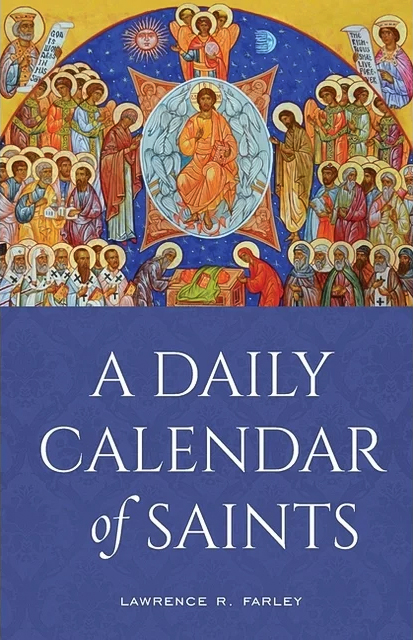A synaxarion of the Orthodox Church is a liturgical text that compiles the lives of saints, feast days, and significant events commemorated throughout the Orthodox Christian liturgical year. Derived from the Greek word “synaxis,” which means gathering or assembly, the synaxarion serves as a collection of hagiographies, providing both historical accounts and spiritual reflections on the saints and martyrs who have helped shape the faith. Each entry typically corresponds to a specific day of the year, aligning with the Church’s calendar, thereby integrating the remembrance of saints into the daily worship and devotional practices of the Orthodox faithful.
Archpriest Lawrence Farley’s Synaxarion offers readers a profound and meticulously researched account of the lives of saints celebrated within the Orthodox Christian tradition. This collection, encompassing the rich tapestry of hagiographical narratives, serves not only as a spiritual guide but also as a historical and cultural treasure trove. Farley’s work stands out for its depth, accessibility, and ability to connect contemporary readers with the timeless virtues and struggles of these holy figures.
The primary purpose of a synaxarion is to educate and edify the faithful by presenting the exemplary lives of the saints as models of Christian virtue and piety. Through these narratives, believers are offered insights into the trials, tribulations, and triumphs of those who have steadfastly followed Christ. The stories often highlight themes of sacrifice, faith, and divine intervention, aiming to inspire readers to emulate these virtues in their own spiritual journeys. By venerating the saints and reflecting on their lives, Orthodox Christians are reminded of the enduring presence and guidance of the saints within the life of the Church.
In addition to its educational role, the synaxarion holds a significant place in the liturgical life of the Orthodox Church. During services, especially the Matins (Orthros) service, readings from the synaxarion are incorporated to commemorate the saint of the day or the particular feast being celebrated. These readings serve to connect the liturgical assembly with the historical and spiritual heritage of the Church, fostering a sense of continuity and communion with the saints. This practice underscores the belief in the “communion of saints,” a fundamental aspect of Orthodox ecclesiology, wherein the faithful on earth and the saints in heaven are united in worship and intercession.
The structure of a synaxarion is typically chronological, following the order of the ecclesiastical calendar from September 1 (the beginning of the Orthodox liturgical year) to August 31. Each entry includes a concise biography of the saint or a description of the feast, accompanied by theological reflections and, often, hymns or prayers related to the commemoration. Some synaxarions are more extensive, providing detailed historical contexts and elaborate accounts of the saints’ miracles and martyrdoms, while others offer brief summaries suitable for daily liturgical use.
Overall, the synaxarion of the Orthodox Church is a vital spiritual and liturgical resource that serves to instruct, inspire, and unify the faithful. By chronicling the lives of saints and significant events in the Church’s history, it fosters a deep sense of continuity with the past and encourages a living connection with the holy men and women who have exemplified the Christian faith. Through the synaxarion, Orthodox Christians are invited to draw strength from the witness of the saints, to deepen their own spiritual lives, and to participate more fully in the liturgical and communal life of the Church.
Content & Insights
The Synaxarion is organized according to the Orthodox liturgical calendar, presenting the lives of saints in a chronological sequence that aligns with their feast days. This structure allows readers to engage with the saints’ stories in a manner that complements their spiritual journey through the year. Each entry provides a detailed biography, contextual historical background, and reflections on the saint’s enduring significance within the Church.
One of the strengths of Farley’s Synaxarion is its rich historical and cultural context. Farley delves into the historical circumstances surrounding each saint, offering insights into the societal and political environments that shaped their lives and ministries. This contextualization helps readers appreciate the saints not just as isolated figures of piety but as individuals who navigated and influenced their worlds in profound ways.
Farley’s Synaxarion is not merely a collection of biographies; it is a source of spiritual nourishment. Each entry is accompanied by reflections that highlight the saint’s spiritual journey and the virtues they embodied. These reflections serve to inspire and challenge readers to emulate the saints’ faith, perseverance, and commitment to Christ in their own lives. Farley’s ability to draw spiritual lessons from historical narratives is both insightful and deeply moving.
Liturgical Integration
Despite the depth of the Synaxarion, Farley’s writing remains accessible and engaging. He avoids overly technical language and instead adopts a narrative style that invites readers into the stories of the saints. This approach makes the Synaxarion suitable for a broad audience, from academics and theologians to lay readers seeking spiritual enrichment.
Farley’s work is deeply integrated with the practices and rhythms of Orthodox worship. The chronological arrangement of the saints’ lives according to the liturgical calendar fosters a sense of connection with the Church’s cycle of feasts and fasts. This integration helps readers to not only learn about the saints but also to participate more fully in the liturgical life of the Orthodox Church.
Illustrative Value
Farley’s Synaxarion also offers comparative insights, occasionally highlighting the differences and similarities between Eastern and Western Christian traditions regarding particular saints. This comparative approach enriches the reader’s understanding of the broader Christian tradition and fosters a sense of unity and diversity within the universal Church.
The Synaxarion is enhanced by illustrative material, including icons and historical maps, which provide visual context and aid in the readers’ engagement with the text. These visuals serve as a bridge between the written word and the rich iconographic tradition of the Orthodox Church, deepening the reader’s appreciation for the saints’ stories.
This work is an invaluable educational resource for anyone interested in hagiography, church history, or Orthodox spirituality. Farley’s meticulous research and thoughtful presentation make the Synaxarion an excellent text for both personal study and academic use. It serves as a comprehensive introduction to the lives of the saints and their enduring impact on the Orthodox Christian faith.
Conclusion
Lawrence Farley’s Synaxarion is a devotional work that brings the lives of the saints to life in a way that is both historically informative and spiritually enriching. Its combination of rigor, accessible prose, and spiritual depth makes it an essential addition to any library. Whether you are a catechumen, a devout practitioner, or someone seeking to deepen your understanding of the Christian faith, Farley’s Synaxarion offers a bountiful collection of wisdom and inspiration.













